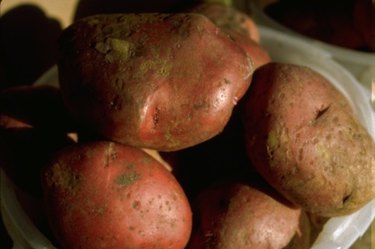Things You'll Need
35 pounds red potatoes
3 gm ascorbic acid
Water
Pressure Canner
7 quart-size canning jars with seals and rings
Salt
Lifter
Labels

Canning the red potatoes from your garden is a good way to store them until you needed. Properly prepared jars packed with potatoes can sit on the pantry shelf for up to a year. Canning low-acid foods like potatoes requires a pressure canner to ensure the food reaches temperatures between 240 degrees Fahrenheit and 250 degrees Fahrenheit, which is the ideal range for killing the bacteria that causes botulism. Thirty-five pounds of potatoes will fill 7 quarts, and 22 ½ pounds of potatoes will fill 9 pint jars.
Step 1
Wash and peel potatoes.
Video of the Day
Step 2
Make a solution of 3 gm of ascorbic acid per 1 gallon of water in a large bowl. Ascorbic acid prevents discoloration caused by enzymes in many foods. It can be found in the baking aisle of most grocery stores.
Step 3
Cut potatoes into 1/2-inch cubes and place into the ascorbic acid solution to prevent darkening over time in the jars.
Step 4
Fill pressure canner with enough water to cover the jars plus 1 inch. Bring to a boil over high heat.
Step 5
Fill a medium saucepan or tea kettle with water, Bring to a boil over high heat. Place clean seals into a heat-resistant bowl or pan. Cover the seals with boiling water to sterilize.
Step 6
Wash empty jars in hot water and detergent. Rinse with clean water. Place jars into boiling water in canner and boil for 10 minutes, uncovered, to sterilize. Remove and drain jars one at a time.
Step 7
Discard all but about 3 inches of the water in the canner. Place the canner's rack in the bottom of the canner.
Step 8
Drain potatoes. Bring a large pot of water to a boil. Boil the potatoes for 2 minutes. Drain.
Step 9
Fill each hot, sterilized jar with hot, drained potatoes, 1 tsp. of salt and fresh hot water, leaving 1 inch of head space.
Step 10
Wipe the rims of the jars with a clean, dry cloth. Center the lid seal on the jar. Screw the ring down until just finger-tight.
Step 11
Place jars on the rack in the canner, being careful not to allow the jars to touch each other.
Step 12
Fasten canner lid securely. Leaving the weight off of the vent port of the canner, heat over high heat until steam flows from the vent port.
Step 13
Exhaust steam for 10 minutes and then place the weight on the vent port. When the dial gauge reaches 11 pounds per square inch (PSI), adjust heat to maintain this pressure. For weighted gauge pressure canners, use the 10 PSI gauge. When the weight begins to jiggle, adjust the heat to maintain this pressure. Adjust for high altitude, if necessary.
Step 14
Process at 11 PSI for 40 minutes for dial-gauge canners and at 10 PSI for 40 minutes for weighted-gauge canners.
Step 15
Remove canner from heat, and let the canner depressurize.
Step 16
Remove the weight form the vent port, but wait two minutes before unlocking the lid. Remove the lid. Remove the jars with a lifter, and place on a towel or cooling rack, leaving space between jars for air to circulate. Allow 24 hours for the jars to completely cool.
Step 17
Press the middle of each jar lid with your finger. If the lid does not spring up when you release your finger, the jar is properly sealed.
Step 18
Place a label on each jar with the processing date and store in a cool, dark, dry place. Any jars that did not properly seal must be refrigerated and used within a couple of days.
Tip
Red potatoes can also be processed in pints. Use 22½ pounds of red potatoes for 9 pints. The steps remain the same except that pints are processed for 35 minutes. To can the potatoes whole instead of cubed, do not cube the potatoes in Step 3, and boil the potatoes for 10 minutes in Step 8. The canner pressure given here is for processing at 0 to 2,000 feet above sea level. For a dial-gauge pressure canner, process at 12 PSI for altitudes from 2,001 to 4,000 feet, 13 PSI from 4,001 to 6,000 feet and 14 PSI above 6,000 feet. For the weighted gauge pressure canners, process at 15 PSI at all altitudes above 1,000 feet.
Warning
Botulism is a deadly form of food poisoning that can grow quickly in under-processed canned goods. Be sure to maintain the proper pressure for the full amount of time to ensure all bacteria is killed in the food.
Video of the Day